Geochemical Characterization of Intraplate Magmatism from Quaternary Alkaline Volcanic Rocks on Jeju Island, South Korea
Abstract
:1. Introduction
2. Geologic Setting
3. Analytical Methods
4. Results
4.1. Major Elements
4.2. Trace and Rare-Earth Elements
5. Discussion
5.1. Fractional Crystallization and Crustal Contamination
5.2. Potential Magma Source
6. Conclusions
Author Contributions
Funding
Conflicts of Interest
References
- Woo, K.; Sohn, Y.; Ahn, U.; Yoon, S.; Spate, A. Geology of Jeju Island. In Jeju Island Geopark—A Volcanic Wonder of Korea. Geoparks of the World; Springer: Berlin/Heidelberg, Germany, 2013. [Google Scholar]
- Nakamura, S. Note on Saishu, volcanic island. Globe 1925, 4, 325–336. [Google Scholar]
- Lee, S.M. Volcanic rocks in Cheju Island, Korea. J. Geol. Soc. Korea 1966, 2, 1–7, (In Korean with English abstract). [Google Scholar]
- Kim, B.K. A stratigraphic and paleontological study of the Sinyangri and Gosanri Formation in the vicinity of Sinyangri in the Jeju Island. J. Geol. Soc. Korea 1969, 15, 103–121. (In Korean) [Google Scholar]
- Kim, B.K. Paleontological study on the sand dune deposits in Jeju Island. J. Geol. Soc. Korea 1974, 10, 95–103. (In Korean) [Google Scholar]
- Taneda, S.; Tsuji, K.; Nakamura, M. Geological, petrological and paleomagnetic studies on the volcanic rocks of Cheju Island. Bull. Volcanol. Soc. Jpn. 1970, 2, 96–108. [Google Scholar]
- Won, C.K. Study of geologic development and the volcanic activity of the Jeju Island. J. Sci. Kun Kook Univ. 1975, 1, 7–48. [Google Scholar]
- Lee, S.K. A Study of Gravity, Crustal Structure and Isostasy of Jeju Island, Korea. Master’s Thesis, Seoul National University, Seoul, Korea, 1981. [Google Scholar]
- Lee, M.W. Geology of Jeju volcanic island, Korea. J. Jpn. Assoc. Mineral. Petrol. Econ. Geol. 1982, 77, 55–64. (In Japanese) [Google Scholar] [CrossRef]
- Lee, M.W. Petrology of Jeju volcanic island, Korea, Part 1, Petrography and bulk chemical composition. J. Jpn. Assoc. Mineral. Petrol. Econ. Geol. 1982, 77, 203–214. (In Japanese) [Google Scholar] [CrossRef]
- Yang, K.; Arai, S.; Yu, J.-E.; Yun, S.-H.; Kim, J.-S.; Hwang, J.-Y. Gabbroic xenoliths and megacrysts in the Pleisto-Holocene alkali basalts from Jeju Island, South Korea: The implications for metasomatism of the lower continental crust. Lithos 2012, 142–143, 201–215. [Google Scholar] [CrossRef]
- Yang, K.H.; Szabo, C.; Arai, S.; Yu, J.E.; Jung, H.Y. Silica enrichment of Group II xenoliths by evolved alkali bas-alt from Jeju Island, South Korea: Implication for modification of intraplate deep-seated rocks. Mineral. Petrol. 2012, 106, 107–130. [Google Scholar] [CrossRef]
- Woo, Y.; Yang, K.; Kil, Y.; Yun, S.-H.; Arai, S. Silica- and LREE-enriched spinel peridotite xenoliths from the Quaternary intraplate alkali basalt, Jeju Island, South Korea: Old subarc fragments? Lithos 2014, 208–209, 312–323. [Google Scholar] [CrossRef]
- Brenna, M.; Cronin, S.; Kereszturi, G.; Sohn, Y.K.; Smith, I.; Wijbrans, J. Intraplate volcanism influenced by distal subduction tectonics at Jeju Island, Republic of Korea. Bull. Volcanol. 2015, 77, 1–16. [Google Scholar] [CrossRef]
- Park, J.B.; Kwon, S.T. Geochemical evolution of the Cheju volcanic island: Petrography and major element chemistry for stratigraphically-controlled lavas from the northern part of Cheju Island. J. Geol. Soc. Korea 1993, 29, 39–60. (In Korean) [Google Scholar]
- Tatsumi, Y.; Shukuno, H.; Yoshikawa, M.; Chang, Q.; Sato, K.; Lee, M.W. The petrology and geochemistry of vol-canic rocks on Jeju Island: Plume magmatism along the Asian continental margin. J. Petrol. 2005, 46, 523–553. [Google Scholar] [CrossRef] [Green Version]
- Choi, S.H.; Mukasa, S.B.; Kwon, S.-T.; Andronikov, A.V. Sr, Nd, Pb and Hf isotopic compositions of late cenozoic alkali basalts in South Korea: Evidence for mixing between the two dominant asthenospheric mantle domains beneath East Asia. Chem. Geol. 2006, 232, 134–151. [Google Scholar] [CrossRef]
- Koh, G.W.; Park, J.B.; Kang, B.R.; Kim, G.P.; Moon, D.C. Volcanism in Jeju Island. J. Geol. Soc. Korea 2013, 49, 209–230. (In Korean) [Google Scholar]
- Lee, W.M. Petrology and geochemistry of Jeju volcanic island, Korea. Sci. Rep. Tohoku Univ. Ser. III 1982, 15, 177–256. (In Japanese) [Google Scholar]
- Baek, S.; Choi, S.H.; Lee, S.G.; Lee, S.R.; Lee, H.M. Geochemistry of anorthositic xenoliths and host tholeiite bas-alt from Jeju Island, South Korea. Geosci. J. 2014, 18, 125–135. [Google Scholar] [CrossRef]
- Kim, J.-I.; Choi, S.H.; Koh, G.W.; Park, J.B.; Ryu, J.-S. Petrogenesis and mantle source characteristics of volcanic rocks on Jeju Island, South Korea. Lithos 2019, 326–327, 476–490. [Google Scholar] [CrossRef]
- Koh, K.; Park, Y.; Park, O. The underground geology and 40Ar-39Ar dating from the eastern part of Jeju Island. Spring geological field trip. J. Geol. Soc. Korea 2004, 29–50. (In Korean) [Google Scholar]
- Sibuet, J.-C.; Letouzey, J.; Barbier, F.; Charvet, J.; Foucher, J.-P.; Hilde, T.W.C.; Kimura, M.; Chiao, L.-Y.; Marsset, B.; Muller, C.; et al. Back arc extension in the okinawa trough. J. Geophys. Res. Space Phys. 1987, 92, 14041–14063. [Google Scholar] [CrossRef] [Green Version]
- Kim, K.H.; Tanaka, T.; Suzuki, K.; Nagao, K.; Park, E.J. Evidences of the presence of old continental basement in Cheju volcanic Island, South Korea, revealed by radiometric ages and Nd-Sr isotopes of granitic rocks. Geochem. J. 2002, 36, 421–441. [Google Scholar] [CrossRef] [Green Version]
- Park, J.B. Geochemical Evolution of the Cheju Volcanic Island, Korea. Ph.D. Thesis, Yonsei University, Seoul, Korea, 1994. [Google Scholar]
- Nakamura, E.; Campbell, I.; McCulloch, M.; Sun, S.-S. Chemical geodynamics in a back arc region around the Sea of Japan: Implications for the genesis of alkaline basalts in Japan, Korea, and China. J. Geophys. Res. Space Phys. 1989, 94, 4634–4654. [Google Scholar] [CrossRef]
- Brenna, M.; Cronin, S.; Smith, I.; Maas, R.; Sohn, Y.K. How small-volume basaltic magmatic systems develop: A case study from the Jeju Island Volcanic Field, Korea. J. Pet. 2012, 53, 985–1018. [Google Scholar] [CrossRef] [Green Version]
- Brenna, M.; Cronin, S.J.; Smith, I.; Sohn, Y.K.; Maas, R. Spatio-temporal evolution of a dispersed magmatic system and its implications for volcano growth, Jeju Island Volcanic Field, Korea. Lithos 2012, 148, 337–352. [Google Scholar] [CrossRef]
- Won, J.K.; Matsuda, J.; Nagao, K.; Kim, K.H.; Lee, M.W. Paleomagnetism and radiometric age of trachytes in Jeju Island, Korea. Korean Soc. Econ. Environ. Geol. 1986, 19, 25–33. (In Korean) [Google Scholar]
- Kim, Y.; Lee, C.; Kim, S.-S. Tectonics and volcanism in East Asia: Insights from geophysical observations. J. Asian Earth Sci. 2015, 113, 842–856. [Google Scholar] [CrossRef]
- Song, J.H.; Kim, S.; Rhie, J.; Lee, S.H.; Kim, Y.H.; Kang, T.S. Imaging of lithospheric structure beneath Jeju vol-canic island by teleseismic traveltime tomography. J. Geophys. Res. Solid Earth 2018, 123, 6784–6801. [Google Scholar]
- Sohn, Y.K.; Park, K.H. Early-stage volcanism and sedimentation of Jeju Island revealed by the Sagye borehole, SW Jeju Island, Korea. Geosci. J. 2004, 8, 73–84. [Google Scholar] [CrossRef]
- Sohn, Y.K.; Park, K.H.; Yoon, S.H. Primary versus secondary and subaerial versus submarine hydrovolcanic de-posits in the subsurface of Jeju Island, Korea. Sedimentology 2008, 55, 899–924. [Google Scholar] [CrossRef]
- Choi, S.H.; Kwon, S.T.; Mukasa, S.B.; Sagong, H. Sr-Nd-Pb isotope and trace element systematics of mantle xenoliths from late Cenozoic alkaline lavas, South Korea. Chem. Geol. 2005, 221, 40–64. [Google Scholar] [CrossRef]
- Kim, Y.S.; Choi, S.H. Plagioclase-rich nodules in Taeheungri basalt from Namwon, Jeju Island and its implica-tions for tholeiite magmatism. J. Geol. Soc. Korea 2012, 48, 313–324. (In Korean) [Google Scholar]
- Park, K.H.; Lee, B.J.; Kim, J.C.; Cho, D.L.; Lee, S.R.; Park, D.W.; Lee, S.; Choi, Y.S.; Yeum, D.Y.; Kim, J.Y.; et al. Explanatory Note of the Jeju (Baekado, Jinnampo Sheet) (1:250,000). Korea Inst. Geol. Min. Mater. 2000, 1–59. [Google Scholar]
- Bas, M.J.L.; Maitre, R.W.L.; Streckeisen, A.; Zanettin, B.; IUGS Subcommission on the Systematics of Igneous Rocks. A chemical classification of volcanic rocks based on the total alkali-silica diagram. J. Pet. 1986, 27, 745–750. [Google Scholar] [CrossRef]
- Irvine, T.N.; Baragar, W.R.A. A guide to the chemical classification of the common volcanic rocks. Can. J. Earth Sci. 1971, 8, 523–548. [Google Scholar] [CrossRef]
- Sun, S.S.; McDonough, W.F. Chemical and isotopic systematics of oceanic basalts: Implications for mantle com-position and processes. Geol. Soc. Lond. Spec. Publ. 1989, 42, 313–345. [Google Scholar] [CrossRef]
- Saunders, A.D.; Norry, M.J.; Tarney, J. Origin of MORB and chemically-depleted mantle reservoirs: Trace element constraints. J. Pet. 1988, 1, 415–445. [Google Scholar] [CrossRef]
- Weaver, B.L. The origin of ocean island basalt end-member compositions: Trace element and isotopic constraints. Earth Planet. Sci. Lett. 1991, 104, 381–397. [Google Scholar] [CrossRef]
- Plank, T.; Langmuir, C.H. The chemical composition of subducting sediment and its consequences for the crust and mantle. Chem. Geol. 1998, 145, 325–394. [Google Scholar] [CrossRef]
- White, W.M.; Klein, E.M.; Holland, H.D.; Turekian, K.K. 4.13-Composition of the oceanic crust. Treatise Geo-Chem. 2014, 4, 457–496. [Google Scholar]
- Frey, F.; Prinz, M. Ultramafic inclusions from San Carlos, Arizona: Petrologic and geochemical data bearing on their petrogenesis. Earth Planet. Sci. Lett. 1978, 38, 129–176. [Google Scholar] [CrossRef]
- El Dien, H.G.; Li, Z.-X.; Kil, Y.; Abu-Alam, T. Origin of arc magmatic signature: A temperature-dependent process for trace element (re)-mobilization in subduction zones. Sci. Rep. 2019, 9, 1–12. [Google Scholar] [CrossRef] [Green Version]
- Secchiari, A.; Montanini, A.; Bosch, D.; Macera, P.; Cluzel, D. Sr, Nd, Pb and trace element systematics of the New Caledonia harzburgites: Tracking source depletion and contamination processes in a SSZ setting. Geosci. Front. 2020, 11, 37–55. [Google Scholar] [CrossRef]
- Ersoy, Y.; Helvacı, C. FC–AFC–FCA and mixing modeler: A Microsoft® Excel© spreadsheet program for modeling geochemical differentiation of magma by crystal fractionation, crustal assimilation and mixing. Comput. Geosci. 2010, 36, 383–390. [Google Scholar] [CrossRef]
- DePaolo, D.J. Trace element and isotopic effects of combined wallrock assimilation and fractional crystallization. Earth Planet. Sci. Lett. 1981, 53, 189–202. [Google Scholar] [CrossRef]
- Zanetti, A.; Tiepolo, M.; Oberti, R.; Vannucci, R. Trace-element partitioning in olivine: Model-ling of a complete data set from a synthetic hydrous basanite melt. Lithos 2004, 75, 39–54. [Google Scholar] [CrossRef]
- McKenzie, D.A.N.; O’nions, R.K. Partial melt distributions from inversion of rare earth element concentra-tions. J. Petrol. 1991, 32, 1021–1091. [Google Scholar] [CrossRef]
- Villemant, B. Trace element evolution in the Phlegrean Fields (Central Italy): Fractional crystallization and selective enrichment. Contrib. Miner. Pet. 1988, 98, 169–183. [Google Scholar] [CrossRef]
- Foley, S.F.; Jackson, S.M.; Fryer, B.J.; Greenouch, J.D.; Jenner, G.A. Trace element partition coef-ficients for clinopyroxene and phlogopite in an alkaline lamprophyre from Newfoundland by LAM-ICP-MS. Geochim. Et Cosmochim. Acta 1996, 60, 629–638. [Google Scholar] [CrossRef]
- Rollinson, H.R. Using Geochemical Data: Evaluation, Presentation, Interpretation; Routledge: London, UK, 1993. [Google Scholar]
- Zack, T.; Brumm, R. Ilmenite/liquid partition coefficients of 26 trace elements determined through ilmenite/clinopyroxene partitioning in garnet pyroxenites. In International Kimberlite Conference: Extended Abstracts; IKC: Cape Town, South Africa, 1998; Volume 7, pp. 986–988. [Google Scholar]
- Taylor, S.R.; McLennan, S. The geochemical evolution of the continental crust. Rev. Geophys. 1995, 33, 241–265. [Google Scholar] [CrossRef]
- Wilson, M.; Downes, H.; Cebriá, J.-M. Contrasting fractionation trends in coexisting continental alkaline magma series; Cantal, Massif Central, France. J. Pet. 1995, 36, 1729–1753. [Google Scholar] [CrossRef]
- Panter, K.S.; Kyle, P.R.; Smellie, J.L. Petrogenesis of a phonolite–trachyte succession at Mount Sidley, Marie Byrd Land, Antarctica. J. Petrol. 1997, 38, 1225–1253. [Google Scholar] [CrossRef]
- Freundt, A.; Schmincke, H.-U. Petrogenesis of rhyolite-trachyte-basalt composite ignimbrite P1, Gran Canada, Canary Islands. J. Geophys. Res. Space Phys. 1995, 100, 455–474. [Google Scholar] [CrossRef] [Green Version]
- Song, Y.; Frey, F.; Zhi, X. Isotopic characteristics of Hannuoba basalts, eastern China: Implications for their petrogenesis and the composition of subcontinental mantle. Chem. Geol. 1990, 88, 35–52. [Google Scholar] [CrossRef]
- Basu, A.R.; Junwen, W.; Wankang, H.; Guanghong, X.; Tatsumoto, M. Major element, REE, and Pb, Nd and Sr iso-topic geochemistry of Cenozoic volcanic rocks of eastern China: Implications for their origin from suboceanic-type mantle reservoirs. Earth Planet. Sci. Lett. 1991, 105, 149–169. [Google Scholar] [CrossRef]
- Derakhshi, M.; Ghasemi, H.; Miao, L. Geochemistry and petrogenesis of Soltan Maidan basalts (E Alborz, Iran): Implications for asthenosphere-lithosphere interaction and rifting along the N margin of Gondwana. Geochemistry 2017, 77, 131–145. [Google Scholar] [CrossRef] [Green Version]
- Tatsumoto, M.; Nakamura, Y. DUPAL anomaly in the sea of Japan: Pb, Nd, and Sr isotopic variations at the eastern Eurasian continental margin. Geochim. Et Cosmochim. Acta 1991, 55, 3697–3708. [Google Scholar] [CrossRef]
- Niu, Y.; O’Hara, M.J.; Pearce, J.A. Initiation of subduction zones as a consequence of lateral compositional buoyancy contrast within the lithosphere: A petrological perspective. J. Pet. 2003, 44, 851–866. [Google Scholar] [CrossRef] [Green Version]
- Weaver, B.L. Trace element evidence for the origin of ocean-island basalts. Geology 1991, 19, 123–126. [Google Scholar] [CrossRef]
- Workman, R.K.; Eiler, J.M.; Hart, S.R.; Jackson, M.G. Oxygen isotopes in Samoan lavas: Confirmation of conti-nent recycling. Geology 2008, 36, 551–554. [Google Scholar] [CrossRef]
- Zindler, A.; Hart, S. Chemical geodynamics. Annu. Rev. Earth Planet. Sci. 1986, 14, 493–571. [Google Scholar] [CrossRef]

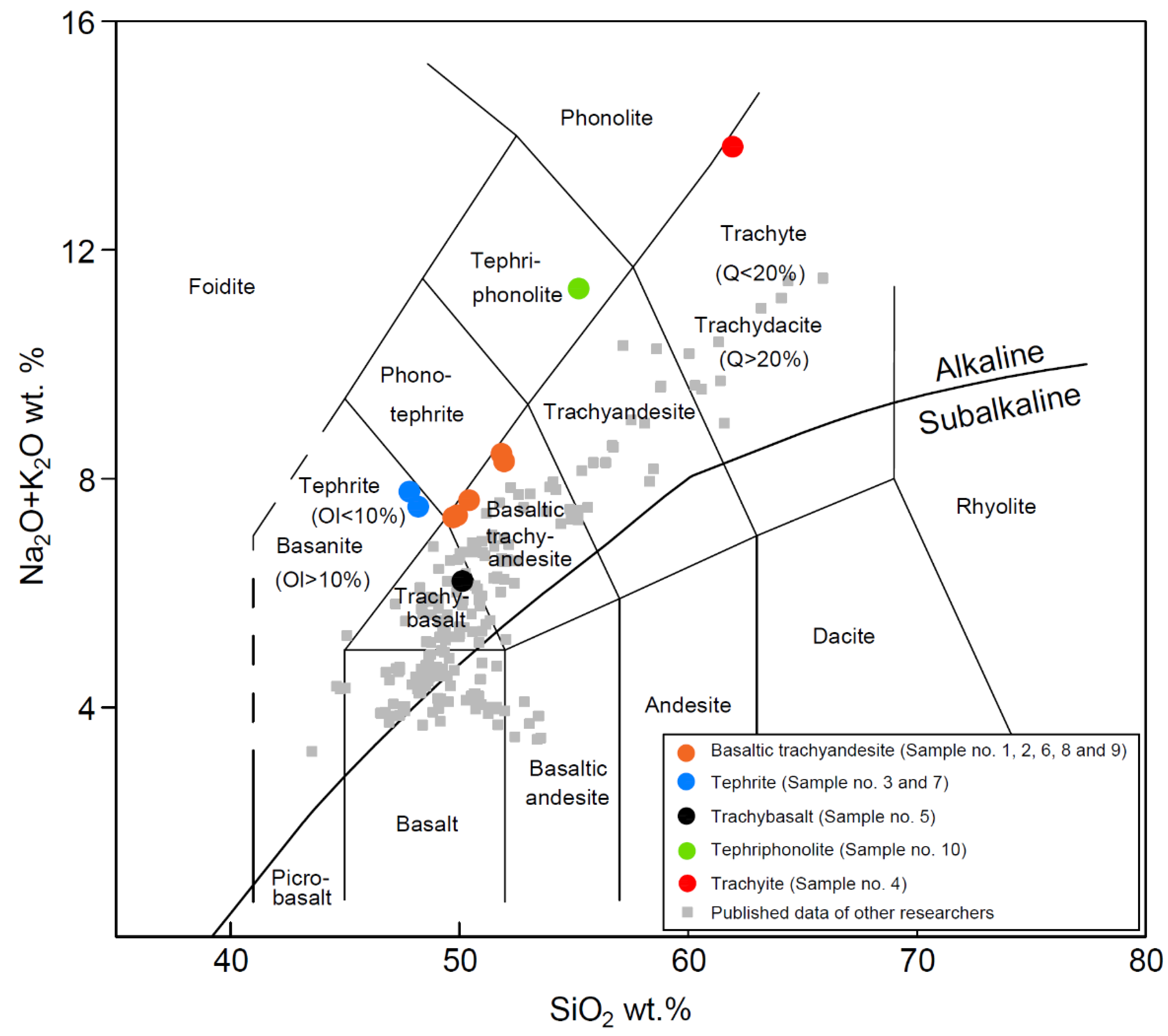
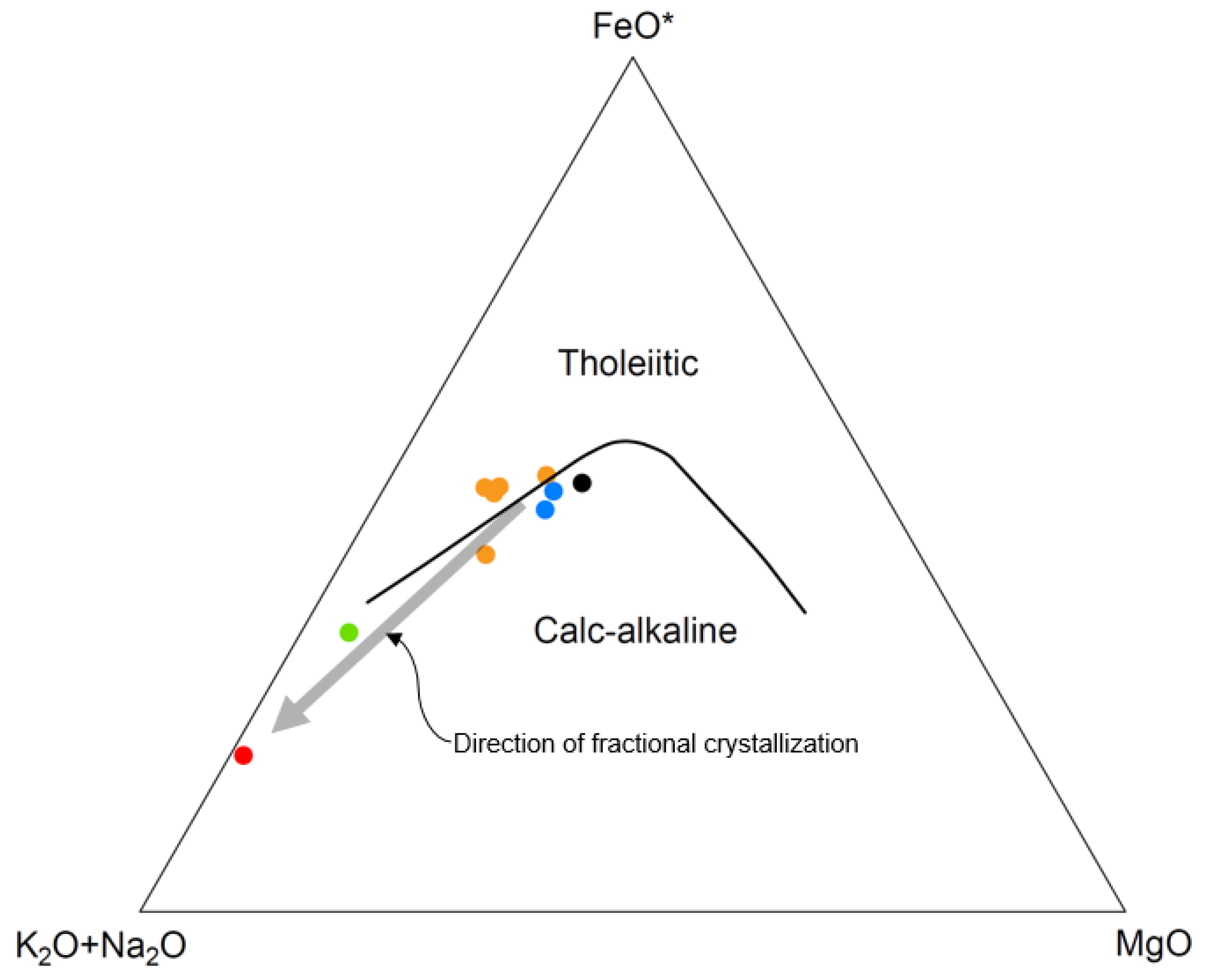

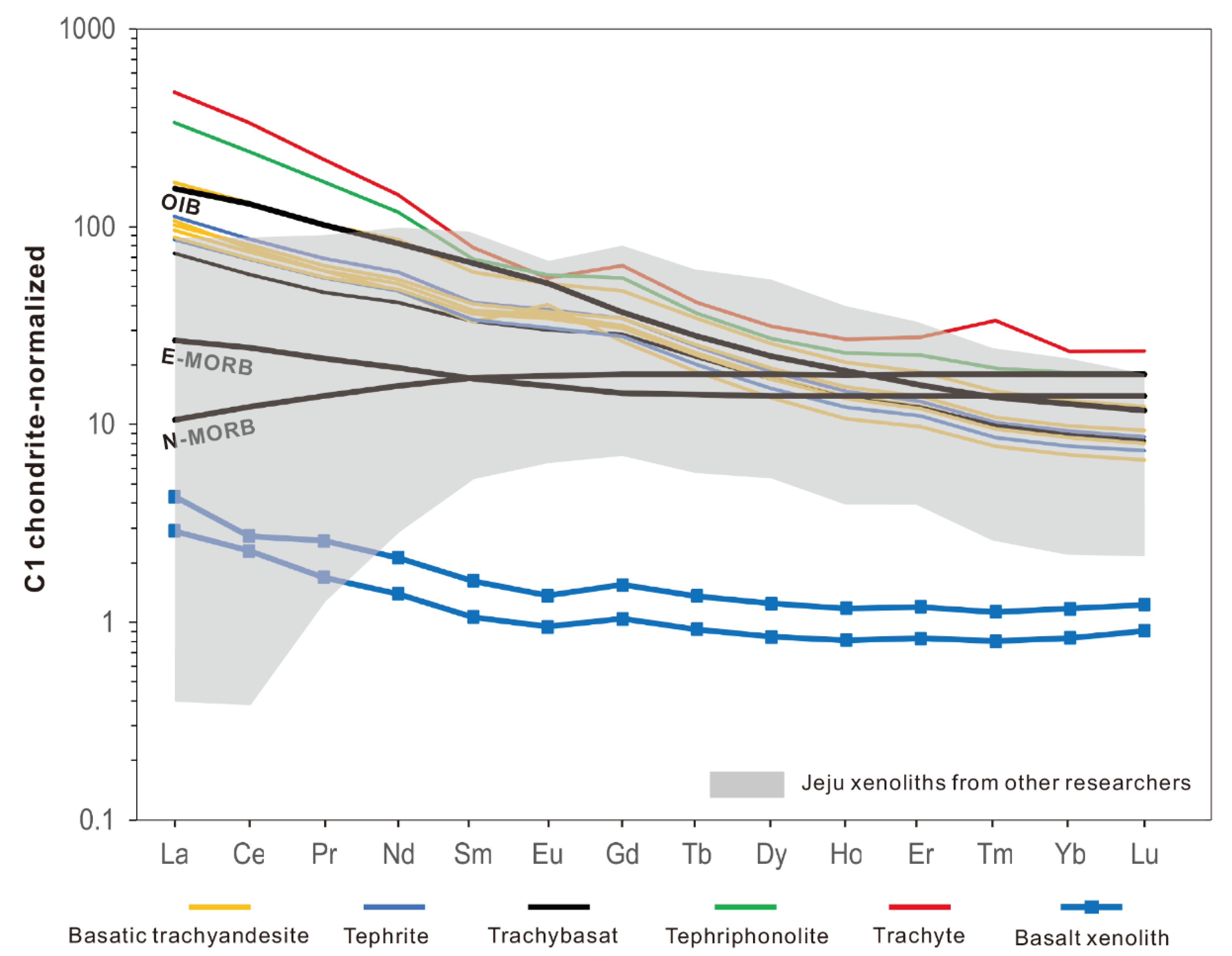
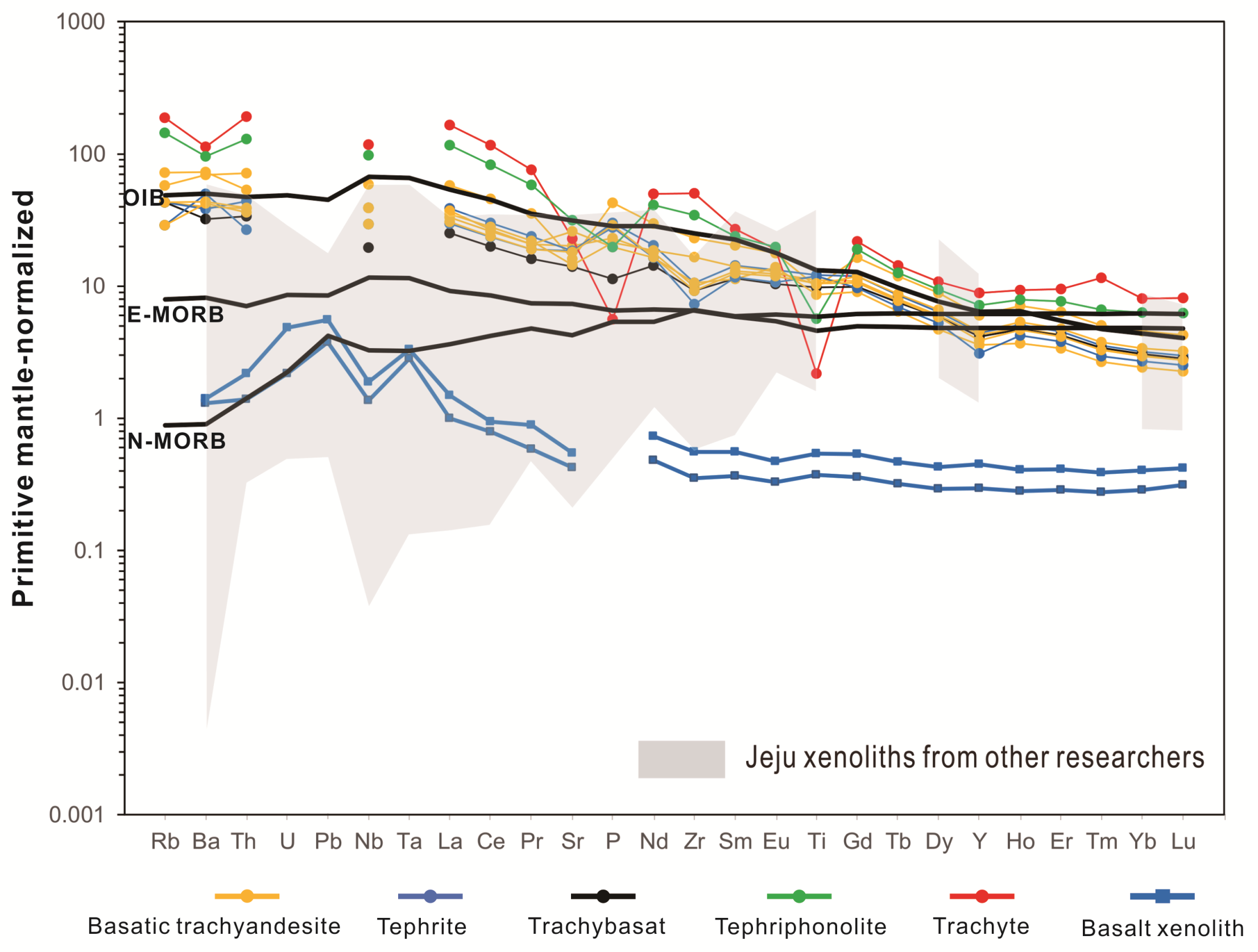
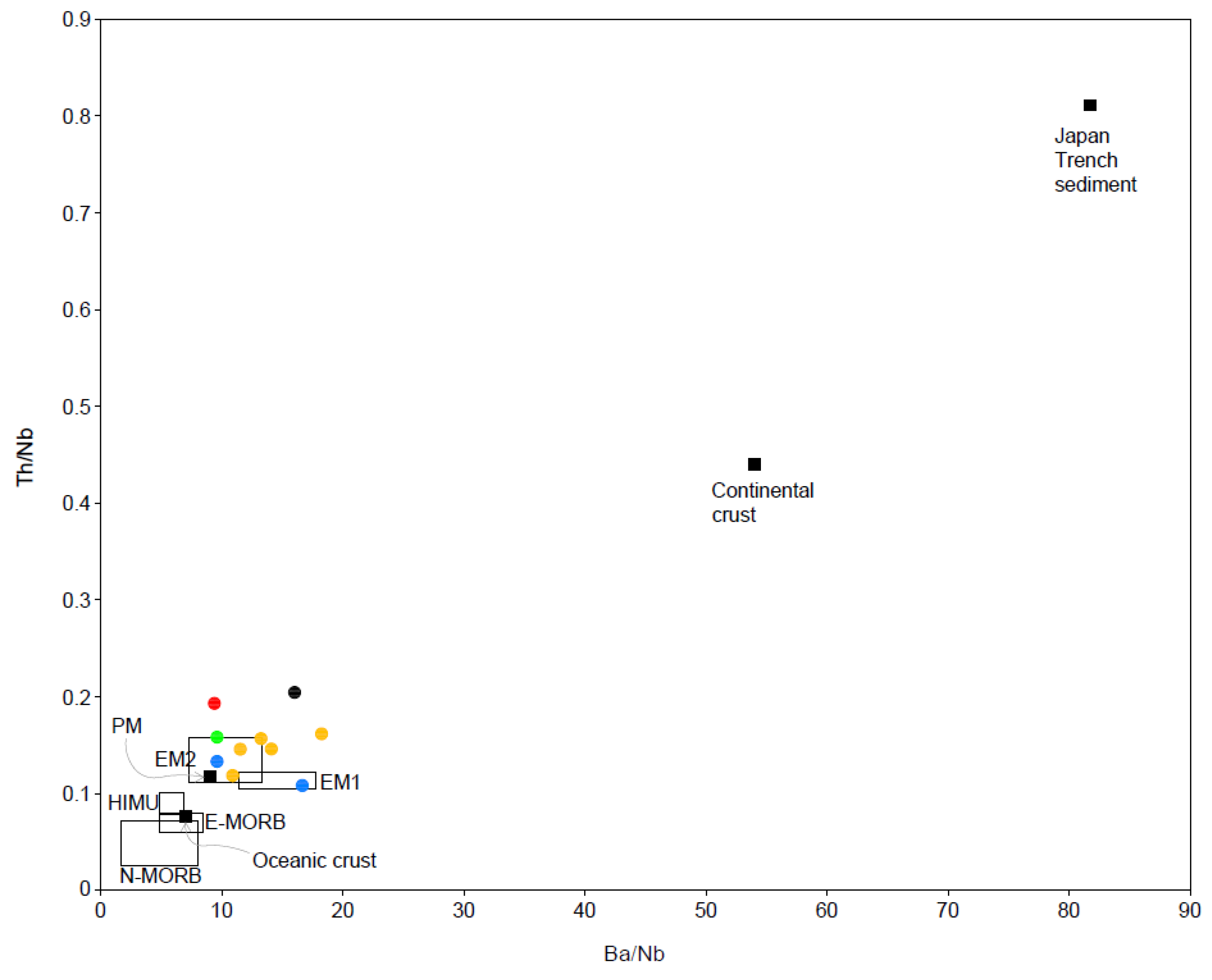


| Sample | 1 | 2 | 3 | 4 | 5 | 6 | 7 | 8 | 9 | 10 | X1 | X2 |
|---|---|---|---|---|---|---|---|---|---|---|---|---|
| Rock Type 1 | BTA | BTA | Te | Tr | TB | BTA | Te | BTA | BTA | TP | Xe | Xe |
| wt.% | ||||||||||||
| SiO2 | 51.95 | 49.90 | 47.82 | 61.94 | 50.13 | 51.85 | 48.21 | 49.73 | 50.43 | 55.21 | 40.08 | 42.70 |
| Al2O3 | 16.77 | 17.74 | 16.76 | 16.84 | 15.85 | 17.35 | 15.89 | 15.91 | 17.50 | 18.20 | 1.97 | 2.35 |
| Na2O | 6.17 | 5.95 | 6.49 | 8.80 | 5.32 | 6.23 | 5.99 | 5.89 | 6.23 | 7.87 | 0.13 | 0.23 |
| Fe2O3 2 | 11.37 | 10.50 | 11.47 | 3.49 | 11.50 | 8.89 | 12.26 | 12.49 | 10.47 | 6.57 | 10.74 | 9.96 |
| CaO | 6.05 | 9.06 | 8.67 | 2.58 | 9.53 | 8.15 | 8.73 | 8.03 | 8.54 | 5.62 | 1.46 | 1.83 |
| K2O | 2.13 | 1.40 | 1.28 | 5.01 | 0.89 | 2.20 | 1.51 | 1.43 | 1.39 | 3.45 | 0.05 | 0.08 |
| TiO2 | 2.15 | 2.40 | 2.64 | 0.47 | 2.11 | 1.88 | 2.58 | 2.22 | 2.27 | 1.23 | 0.08 | 0.12 |
| MgO | 2.10 | 2.20 | 3.86 | 0.23 | 4.08 | 2.72 | 3.90 | 3.46 | 2.20 | 0.88 | 45.06 | 42.36 |
| P2O5 | 0.93 | 0.50 | 0.66 | 0.12 | 0.25 | 0.43 | 0.61 | 0.47 | 0.63 | 0.43 | nd | nd |
| MnO | 0.17 | 0.13 | 0.16 | 0.23 | 0.15 | 0.11 | 0.17 | 0.17 | 0.14 | 0.24 | 0.13 | 0.12 |
| Total | 99.78 | 99.79 | 99.80 | 99.70 | 99.80 | 99.79 | 99.83 | 99.80 | 99.79 | 99.71 | 99.70 | 99.75 |
| Mg # 3 | 34.32 | 37.28 | 48.79 | 15.74 | 50.12 | 46.44 | 47.37 | 44.00 | 37.29 | 27.56 | 92.24 | 92.33 |
| Concentrations in ppm | ||||||||||||
| Sc | 10.67 | 12.68 | 14.57 | nd | 14.37 | 7.21 | 12.94 | 14.80 | 10.64 | 3.18 | 0.69 | 1.02 |
| La | 39.54 | 22.71 | 26.69 | 113.39 | 17.38 | 25.44 | 20.33 | 24.12 | 20.96 | 79.74 | 0.69 | 1.02 |
| Ce | 81.16 | 45.82 | 53.19 | 206.62 | 35.22 | 47.52 | 41.82 | 49.80 | 42.20 | 147.15 | 1.40 | 1.67 |
| Pr | 9.74 | 5.70 | 6.58 | 20.84 | 4.44 | 5.69 | 5.25 | 6.06 | 5.26 | 16.01 | 0.16 | 0.25 |
| Nd | 40.14 | 24.13 | 27.50 | 67.80 | 19.34 | 22.12 | 22.21 | 25.25 | 22.51 | 55.41 | 0.65 | 0.99 |
| Sm | 9.05 | 5.76 | 6.36 | 11.99 | 5.09 | 5.05 | 5.17 | 6.23 | 5.53 | 10.52 | 0.16 | 0.25 |
| Eu | 2.99 | 2.08 | 2.22 | 3.20 | 1.75 | 2.33 | 1.79 | 2.16 | 2.00 | 3.31 | 0.06 | 0.08 |
| Gd | 9.76 | 6.49 | 7.08 | 13.02 | 5.89 | 5.40 | 5.75 | 7.07 | 6.30 | 11.31 | 0.21 | 0.32 |
| Tb | 1.29 | 0.86 | 0.92 | 1.55 | 0.81 | 0.69 | 0.75 | 0.94 | 0.84 | 1.36 | 0.03 | 0.05 |
| Dy | 6.53 | 4.44 | 4.70 | 7.96 | 4.29 | 3.46 | 3.87 | 4.90 | 4.31 | 6.92 | 0.21 | 0.32 |
| Ho | 1.17 | 0.78 | 0.83 | 1.53 | 0.77 | 0.60 | 0.69 | 0.87 | 0.77 | 1.30 | 0.05 | 0.07 |
| Er | 3.06 | 2.05 | 2.17 | 4.56 | 2.02 | 1.62 | 1.83 | 2.29 | 2.00 | 3.69 | 0.14 | 0.20 |
| Tm | 0.37 | 0.25 | 0.26 | 0.85 | 0.25 | 0.20 | 0.22 | 0.28 | 0.24 | 0.49 | 0.02 | 0.03 |
| Yb | 2.25 | 1.48 | 1.57 | 3.97 | 1.51 | 1.19 | 1.33 | 1.67 | 1.45 | 3.11 | 0.14 | 0.20 |
| Lu | 0.31 | 0.21 | 0.22 | 0.60 | 0.21 | 0.17 | 0.19 | 0.24 | 0.20 | 0.46 | 0.02 | 0.03 |
| Zr | 259.11 | 111.05 | 118.45 | 562.64 | 103.64 | 118.45 | 81.43 | 185.08 | 103.64 | 384.96 | 3.94 | 6.22 |
| Nb | 41.94 | 20.97 | 27.96 | 83.88 | 13.98 | 27.96 | 20.97 | 27.96 | 20.97 | 69.90 | 0.97 | 1.34 |
| Rb | 36.58 | 27.43 | 27.43 | 118.87 | 27.43 | 45.72 | 18.29 | 27.43 | 18.29 | 91.44 | ||
| Ba | 483.48 | 277.56 | 268.60 | 787.90 | 223.84 | 510.34 | 349.18 | 304.42 | 295.46 | 671.51 | 9.12 | 9.78 |
| Th | 6.10 | 3.28 | 3.72 | 16.19 | 2.86 | 4.51 | 2.26 | 3.31 | 3.06 | 11.05 | 0.12 | 0.19 |
| U | 0.05 | 0.10 | ||||||||||
| Ta | 0.12 | 0.14 | ||||||||||
| K | 412.97 | 644.25 | ||||||||||
| Pb | 0.27 | 0.40 | ||||||||||
| Sr | 338.24 | 422.80 | 388.97 | 481.99 | 295.96 | 549.63 | 388.97 | 304.41 | 380.52 | 668.02 | 8.95 | 11.51 |
| Ti | 484.22 | 702.62 | ||||||||||
| Y | 27.21 | 19.70 | 20.14 | 40.39 | 18.93 | 16.35 | 14.07 | 20.58 | 17.61 | 32.66 | 1.35 | 2.05 |
| (La/Sm)N | 2.73 | 2.46 | 2.62 | 5.91 | 2.13 | 3.15 | 2.46 | 2.42 | 2.37 | 4.73 | 2.64 | 2.57 |
| (La/Lu)N | 13.05 | 11.32 | 12.60 | 19.58 | 8.57 | 15.71 | 11.28 | 10.53 | 10.67 | 17.99 | 3.09 | 3.41 |
| (Eu/Eu*) | 0.97 | 1.04 | 1.01 | 0.78 | 0.97 | 1.36 | 1.00 | 0.99 | 1.03 | 0.93 | 0.90 | 0.86 |
| (Ce/Ce*) | 1.00 | 0.97 | 0.97 | 1.03 | 0.97 | 0.96 | 0.98 | 1.00 | 0.97 | 1.00 | 1.02 | 0.81 |
| CIPW normative mineralogy(wt.%) 4 | ||||||||||||
| plag | 54.61 | 49.51 | 39.21 | 47.38 | 49.75 | 44.67 | 38.71 | 45.81 | 50.46 | 41.52 | 5.86 | 7.09 |
| or | 12.59 | 8.27 | 7.56 | 29.61 | 5.26 | 13.00 | 8.92 | 8.45 | 8.21 | 20.39 | 0.30 | 0.47 |
| ne | 5.08 | 9.96 | 15.45 | 6.15 | 6.50 | 11.33 | 12.99 | 9.09 | 9.72 | 15.83 | - | - |
| cpx | 10.17 | 19.99 | 21.13 | 8.14 | 23.65 | 20.29 | 22.38 | 19.82 | 18.73 | 12.98 | 2.15 | 3.09 |
| opx | - | - | - | - | - | - | - | - | - | - | 1.00 | 13.35 |
| wo | - | - | - | 1.12 | - | - | - | - | - | 2.34 | - | - |
| ol | 5.36 | 1.01 | 4.11 | - | 4.25 | 1.45 | 4.34 | 5.01 | 1.61 | - | 84.84 | 70.48 |
| ac | - | - | - | 3.04 | - | - | - | - | - | - | - | - |
| ns | - | - | - | 2.86 | - | - | - | -- | - | - | - | |
| il | 4.08 | 4.56 | 5.01 | 0.89 | 4.01 | 3.57 | 4.90 | 4.22 | 4.31 | 2.34 | 0.15 | 0.23 |
| mt | 4.96 | 4.57 | 5.00 | - | 5.02 | 3.87 | 5.34 | 5.44 | 4.57 | 2.86 | 4.68 | 4.34 |
| ap | 2.15 | 1.16 | 1.53 | 0.28 | 0.58 | 1.00 | 1.41 | 1.09 | 1.46 | 1.00 | - | - |
| Total | 99.00 | 99.03 | 99.00 | 99.47 | 99.02 | 99.18 | 98.99 | 98.93 | 99.07 | 99.26 | 98.98 | 99.05 |
| Zr/Nb | La/Nb | Ba/Nb | Ba/Th | Rb/Nb | K/Nb | Th/Nb | Th/La | Ba/La | |
|---|---|---|---|---|---|---|---|---|---|
| Primitive mantle * | 14.8 | 0.94 | 9 | 77 | 0.91 | 323 | 0.117 | 0.125 | 9.6 |
| N-MORB * | 30 | 1.07 | 1.7–8.0 | 60 | 0.36 | 210–350 | 0.025–0.071 | 0.067 | 4 |
| E-MORB * | 4.9–8.5 | 205–230 | 0.06–0.08 | ||||||
| Continental crust * | 16.2 | 2.2 | 54 | 124 | 4.7 | 1341 | 0.44 | 0.204 | 25 |
| HIMU–OIB * | 3.2–5.0 | 0.66–0.77 | 4.9–6.9 | 49–77 | 0.35–0.38 | 77–179 | 0.078–0.101 | 0.107–0.133 | 6.8–8.7 |
| EM1–OIB * | 1.2–11.5 | 0.86–1.19 | 11.4–17.8 | 103–154 | 0.88–1.17 | 213–432 | 0.105–0.122 | 0.107–0.128 | 13.2–16.9 |
| EM2–OIB * | 4.5–7.3 | 0.89–1.09 | 7.3–13.3 | 67–84 | 0.59–0.85 | 248–378 | 0.111–0.157 | 0.122–0.163 | 8.3–11.3 |
| Jeju Island alk. volcanics | 3.9–7.4 | 0.86–1.35 | 9.4–18.3 | 49–154 | 0.87–1.96 | 394–652 | 0.108–0.204 | 0.111–0.177 | 6.9–20.1 |
| Average of Jeju | 5.5 | 1.05 | 12.9 | 88 | 1.22 | 501 | 0.152 | 0.146 | 12.7 |
Publisher’s Note: MDPI stays neutral with regard to jurisdictional claims in published maps and institutional affiliations. |
© 2021 by the authors. Licensee MDPI, Basel, Switzerland. This article is an open access article distributed under the terms and conditions of the Creative Commons Attribution (CC BY) license (https://creativecommons.org/licenses/by/4.0/).
Share and Cite
Kim, C.; Khant, N.A.; Jeon, Y.; Kim, H.; Lim, C. Geochemical Characterization of Intraplate Magmatism from Quaternary Alkaline Volcanic Rocks on Jeju Island, South Korea. Appl. Sci. 2021, 11, 7030. https://doi.org/10.3390/app11157030
Kim C, Khant NA, Jeon Y, Kim H, Lim C. Geochemical Characterization of Intraplate Magmatism from Quaternary Alkaline Volcanic Rocks on Jeju Island, South Korea. Applied Sciences. 2021; 11(15):7030. https://doi.org/10.3390/app11157030
Chicago/Turabian StyleKim, Cheolhong, Naing Aung Khant, Yongmun Jeon, Heejung Kim, and Chungwan Lim. 2021. "Geochemical Characterization of Intraplate Magmatism from Quaternary Alkaline Volcanic Rocks on Jeju Island, South Korea" Applied Sciences 11, no. 15: 7030. https://doi.org/10.3390/app11157030






